初中介词(表时间地点介词)讲解练习及答案
初中介词(表时间地点介词)讲解练习及答案
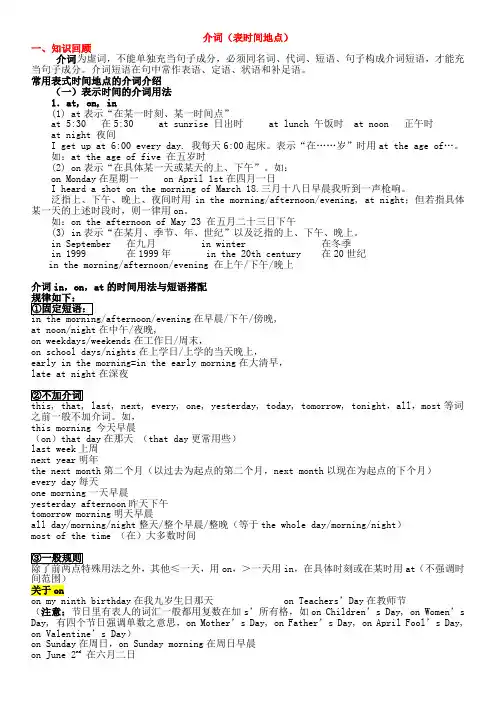
介词(表时间地点)一、知识回顾介词为虚词,不能单独充当句子成分,必须同名词、代词、短语、句子构成介词短语,才能充当句子成分。
介词短语在句中常作表语、定语、状语和补足语。
常用表式时间地点的介词介绍(一)表示时间的介词用法1.at, on, in(1) at表示“在某一时刻、某一时间点”at 5:30 在5:30 at sunrise 日出时 at lunch 午饭时 at noon 正午时at night 夜间I get up at 6:00 every day. 我每天6:00起床。
表示“在……岁”时用at the age of…。
如:at the age of five 在五岁时(2) on表示“在具体某一天或某天的上、下午”。
如:on Monday在星期一 on April 1st在四月一日I heard a shot on the morning of March 18.三月十八日早晨我听到一声枪响。
泛指上、下午、晚上、夜间时用in the morning/afternoon/evening, at night;但若指具体某一天的上述时段时,则一律用on。
如:on the afternoon of May 23 在五月二十三日下午(3) in表示“在某月、季节、年、世纪”以及泛指的上、下午、晚上。
in September 在九月in winter 在冬季in 1999 在1999年 in the 20th century 在20世纪in the morning/afternoon/evening 在上午/下午/晚上介词in,on,at的时间用法与短语搭配在早晨/下午/傍晚,at noon/night在中午/夜晚,on weekdays/weekends在工作日/周末,on school days/nights在上学日/上学的当天晚上,early in the morning=in the early morning在大清早,late at night在深夜,all,most等词之前一般不加介词。
(完整word版)初中介词(表时间地点介词)讲解练习及答案.doc
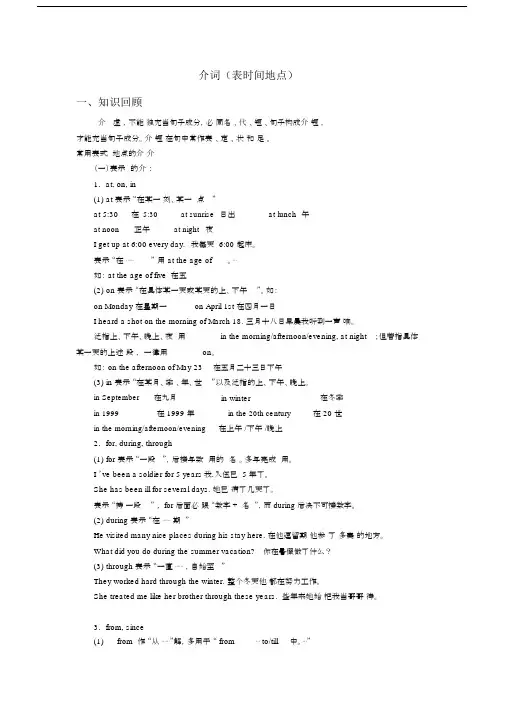
介词(表时间地点)一、知识回顾介虚,不能独充当句子成分,必同名、代、短、句子构成介短,才能充当句子成分。
介短在句中常作表、定、状和足。
常用表式地点的介介(一)表示的介:1. at, on, in(1)at 表示“在某一刻、某一点”at 5:30 在5:30 at sunrise 日出at lunch 午at noon 正午at night 夜I get up at 6:00 every day.我每天6:00起床。
表示“在⋯⋯” 用at the age of。
⋯如: at the age of five 在五(2)on 表示“在具体某一天或某天的上、下午”。
如:on Monday 在星期一on April 1st 在四月一日I heard a shot on the morning of March 18. 三月十八日早晨我听到一声响。
泛指上、下午、晚上、夜用in the morning/afternoon/evening, at night;但若指具体某一天的上述段,一律用on。
如: on the afternoon of May 23在五月二十三日下午(3)in 表示“在某月、季、年、世”以及泛指的上、下午、晚上。
in September 在九月in winter 在冬季in 1999 在 1999 年in the 20th century 在 20 世in the morning/afternoon/evening 在上午 /下午 /晚上2. for, during, through(1)for 表示“一段”,后接与数用的名。
多与完成用。
I ’ve been a soldier for 5 years我.入伍已 5 年了。
She has been ill for several days. 她已病了几天了。
表示“持一段” , for 后面必跟“数字 +名”,而 during 后决不可接数字。
初中英语介词专项讲解及练习(包含答案)
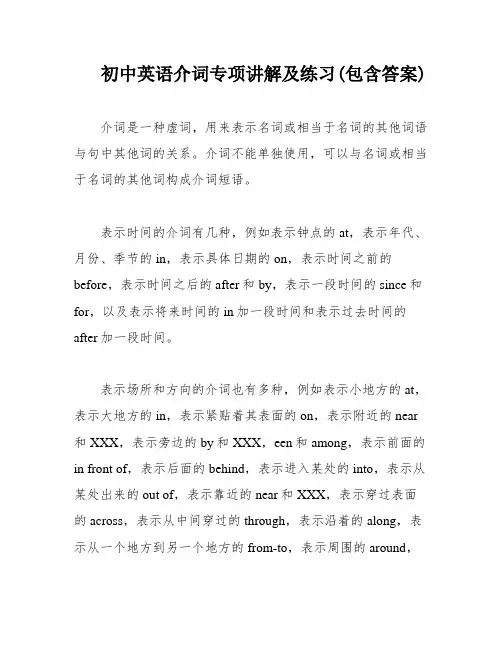
初中英语介词专项讲解及练习(包含答案)介词是一种虚词,用来表示名词或相当于名词的其他词语与句中其他词的关系。
介词不能单独使用,可以与名词或相当于名词的其他词构成介词短语。
表示时间的介词有几种,例如表示钟点的at,表示年代、月份、季节的in,表示具体日期的on,表示时间之前的before,表示时间之后的after和by,表示一段时间的since和for,以及表示将来时间的in加一段时间和表示过去时间的after加一段时间。
表示场所和方向的介词也有多种,例如表示小地方的at,表示大地方的in,表示紧贴着其表面的on,表示附近的near和XXX,表示旁边的by和XXX,een和among,表示前面的in front of,表示后面的behind,表示进入某处的into,表示从某处出来的out of,表示靠近的near和XXX,表示穿过表面的across,表示从中间穿过的through,表示沿着的along,表示从一个地方到另一个地方的from-to,表示周围的around,表示正上方的over,表示正下方的under,表示斜上方的above,表示斜下方的below。
介词的使用需要根据具体情况来判断,掌握介词的用法可以帮助我们更准确地表达自己的意思。
In using a language。
it'XXX to know about the culture and customs of the people you are XXX my experience。
as someone who has lived in different countries。
it's important to adapt and be respectful。
just like you would in your own country.With the right clothing and knowledge。
you can XXX。
(完整word版)初中介词(表时间地点介词)讲解练习及答案.doc

介词(表时间地点)一、知识回顾介虚,不能独充当句子成分,必同名、代、短、句子构成介短,才能充当句子成分。
介短在句中常作表、定、状和足。
常用表式地点的介介(一)表示的介:1. at, on, in(1)at 表示“在某一刻、某一点”at 5:30 在5:30 at sunrise 日出at lunch 午at noon 正午at night 夜I get up at 6:00 every day.我每天6:00起床。
表示“在⋯⋯” 用at the age of。
⋯如: at the age of five 在五(2)on 表示“在具体某一天或某天的上、下午”。
如:on Monday 在星期一on April 1st 在四月一日I heard a shot on the morning of March 18. 三月十八日早晨我听到一声响。
泛指上、下午、晚上、夜用in the morning/afternoon/evening, at night;但若指具体某一天的上述段,一律用on。
如: on the afternoon of May 23在五月二十三日下午(3)in 表示“在某月、季、年、世”以及泛指的上、下午、晚上。
in September 在九月in winter 在冬季in 1999 在 1999 年in the 20th century 在 20 世in the morning/afternoon/evening 在上午 /下午 /晚上2. for, during, through(1)for 表示“一段”,后接与数用的名。
多与完成用。
I ’ve been a soldier for 5 years我.入伍已 5 年了。
She has been ill for several days. 她已病了几天了。
表示“持一段” , for 后面必跟“数字 +名”,而 during 后决不可接数字。
初中英语介词试题(有答案和解析)含解析
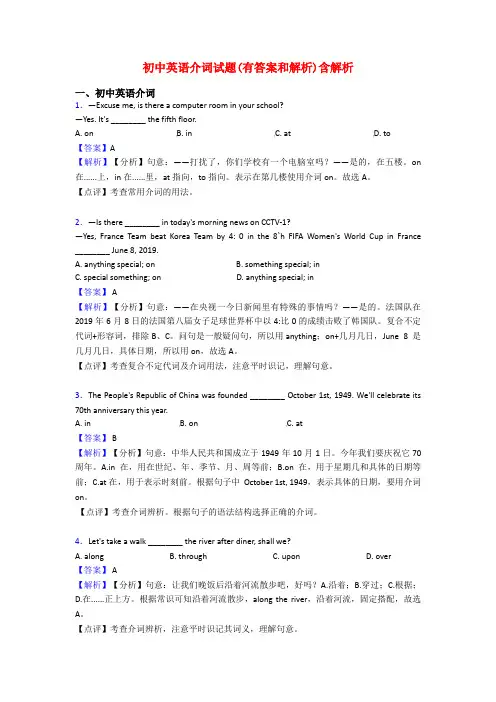
初中英语介词试题(有答案和解析)含解析一、初中英语介词1.—Excuse me, is there a computer room in your school?—Yes. It's ________ the fifth floor.A. onB. inC. atD. to【答案】A【解析】【分析】句意:——打扰了,你们学校有一个电脑室吗?——是的,在五楼。
on 在......上,in在......里,at指向,to指向。
表示在第几楼使用介词on。
故选A。
【点评】考查常用介词的用法。
2.—Is there ________ in today's morning news on CCTV-1?—Yes, France Team beat Korea Team by 4: 0 in the 8`h FIFA Women's World Cup in France ________ June 8, 2019.A. anything special; onB. something special; inC. special something; onD. anything special; in【答案】 A【解析】【分析】句意:——在央视一今日新闻里有特殊的事情吗?——是的。
法国队在2019年6月8日的法国第八届女子足球世界杯中以4:比0的成绩击败了韩国队。
复合不定代词+形容词,排除B、C。
问句是一般疑问句,所以用anything;on+几月几日,June 8 是几月几日,具体日期,所以用on,故选A。
【点评】考查复合不定代词及介词用法,注意平时识记,理解句意。
3.The People's Republic of China was founded ________ October 1st, 1949. We'll celebrate its 70th anniversary this year.A. inB. onC. at【答案】 B【解析】【分析】句意:中华人民共和国成立于1949年10月1日。
初中英语七年级方位介词详解及练习
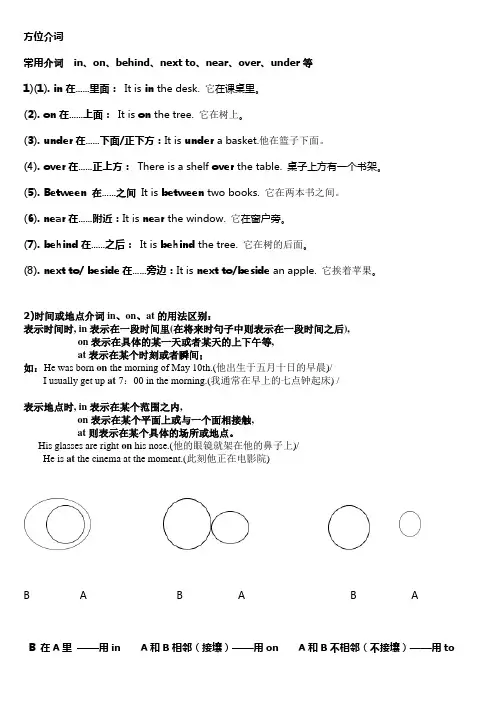
方位介词常用介词in、on、behind、next to、near、over、under等1)(1). in在……里面:It is in the desk.它在课桌里。
(2). on在……上面:It is on the tree.它在树上。
(3). under在……下面/正下方:It is under a basket.他在篮子下面。
(4). over在……正上方:There is a shelf over the table.桌子上方有一个书架。
(5). Between 在……之间It is between two books. 它在两本书之间。
(6). near在……附近:It is near the window. 它在窗户旁。
(7). behind在……之后:It is behind the tree. 它在树的后面。
(8). next to/ beside在……旁边:It is next to/beside an apple. 它挨着苹果。
2)时间或地点介词in、on、at的用法区别:表示时间时, in表示在一段时间里(在将来时句子中则表示在一段时间之后),on表示在具体的某一天或者某天的上下午等,at表示在某个时刻或者瞬间;如:He was born on the morning of May 10th.(他出生于五月十日的早晨)/I usually get up at 7:00 in the morning.(我通常在早上的七点钟起床) /表示地点时, in表示在某个范围之内,on表示在某个平面上或与一个面相接触,at则表示在某个具体的场所或地点。
His glasses are right on his nose.(他的眼镜就架在他的鼻子上)/He is at the cinema at the moment.(此刻他正在电影院)B A B A B AB 在A里——用in A和B相邻(接壤)——用on A和B不相邻(不接壤)——用to3) in front of “在…之前”(范围外)in the front of 表示“在…的前部”(范围内)实战演练1. The United States is ____ the south of Canada and ___ the east of Japan.A. to; inB. on; toC. in; besideD. at; on2 . Japan lies____ the east of China.A. on B/ to C. in D. with3. Jiangsu is___ the east of China, but Japan is ___ the east of China.A. to; inB. in; to .C. on; toD. to; on4. There are some trees_________ the classroomThere is a blackboard ____________ the classroom.A. in front ofB. in the front of5. —Look, there are many apples ______ the tree.—Yes. And a boy is picking apples ______ the tree now.A. in; onB. on; inC. in; inD. on; on6. When did you arrive ______school this morning?A. inB. atC. toD. with。
初中英语介词解题技巧讲解及练习题(含答案)含解析
初中英语介词解题技巧讲解及练习题(含答案)含解析一、初中英语介词1.Our classes are over noon and then we go to have a rest 1:00 in the afternoon. A. at; at B. in; in C. in; at D. at; in【答案】 A【解析】【分析】句意:我们的课在中午结束,然后我们在下午一点去休息。
第一个空,at noon在中午,固定搭配;第二个空,在具体时刻的前面要用介词at;故选A。
【点评】考查介词。
2.The high-speed train Qingdao and Beijing travels faster now. The train ride takes only about three hours.A. fromB. amongC. inD. between【答案】 D【解析】【分析】句意:现在青岛和北京之间的高速列车跑得更快了。
火车车程只有大约三个小时。
from 从;among 在……中;in 在……里;between 在……之间;根据后面的and,可知是固定搭配,between…and…,在……和……之间,故选D。
【点评】此题考查介词辨析。
根据句意和上下文的联系确定所使用的介词。
3.—Is that your headmaster?—You mean the man ________ blue?A. onB. withC. in【答案】 C【解析】【分析】句意:——那是你的校长吗?——你是指穿着蓝色衣服的男士吗?固定搭配,in+颜色,穿着……颜色衣服的人,A 在……上面,B 和……,表伴随,与题意不符,故选C。
【点评】考查介词辨析,注意in+颜色的用法。
4.We communicate _____ each other in many ways, such as by e-mail or by phone.A. onB. throughC. inD. with【答案】 D【解析】【分析】句意:我们用很多方法相互联系,比如通过电子邮件或者电话。
介词in,on,at及其练习附答案(解析版)
介词in,on,at及其练习附答案(解析版)介词in、on和at在表示时间的名词前的使用有所不同。
具体区别如下:一、使用in的情况:1.表示“在某年/月/季节”时,需要使用介词in。
例如:她于1980年来到这个城市。
夏天这里经常下雨。
2.表示“从现在起一段时间以后”时,需要使用介词in。
例如:他们将在一周后去看望你。
我将在一个月后回来。
3.表示“在某个世纪”时,需要使用介词in。
例如:这台机器是在18世纪发明的。
20世纪发生了巨大变化。
4.表示“在某个年代或特定世纪某个年代”时,需要使用介词in。
例如:该事件发生在20世纪70年代。
抗日战争爆发于20世纪30年代。
5.除此之外,morning、evening和afternoon三个词也常与介词in连用。
例如:晚上看电视不要太多。
他们有时在下午做游戏。
二、使用on的情况:1.表示“在具体的某一天”或“(在具体的某一天的)早上、中午、晚上”等,需要使用介词on。
例如:杰克生于1982年5月10日。
他们是在一个雨天的早上离开的。
他于一个夏天的下午返回了美国。
2) 表示星期几或其时间,需使用介词on。
例如:我们星期六和星期天不上学。
平日你几点起床?我是在星期六的早晨听到这个故事的。
3) 表示某个节日,需使用介词on。
例如:我们通常在中秋节吃月饼。
胡老师在教师节那天收到了一张卡片。
1) 表示具体时间点,需使用介词at。
例如:他每天六点起床。
昨天下午五点半我到家了。
2) 表示特定的时节或时机,需使用介词at。
例如:他们那时很幸福。
我认为商店在白天的这个时候关门了。
3) 表示中午、夜晚或周末,需使用介词at。
例如:你中午经常做些什么?夜晚你能看到天空中有许多星星。
4) 表示某个年龄,需使用介词at。
例如:这个男孩在九岁的时候就游泳游得很好了。
When I was twenty years old。
I started teaching English at a school。
(完整)初中英语七年级时间介词详解及练习
(完整)初中英语七年级时间介词详解及练习初中英语七年级时间介词详解及练1. 介词的概述在英语中,介词(Preposition)是一种重要的词类,用来表示名词、代词或动词与其他词之间的关系。
在描述时间的时候,我们常常会用到时间介词。
2. 常用的时间介词以下是七年级初中英语常用的时间介词及其用法:- at:表示具体的时刻,多用于准确的钟点时间。
例如:“at 8 o'clock”(在8点钟)。
at:表示具体的时刻,多用于准确的钟点时间。
例如:“at 8 o'clock”(在8点钟)。
- on:表示具体的某一天或日期。
例如:“on Monday”(在星期一)。
on:表示具体的某一天或日期。
例如:“on Monday”(在星期一)。
- in:表示较长的时间段,如月份、季节、年份等。
例如:“in July”(在七月)。
in:表示较长的时间段,如月份、季节、年份等。
例如:“in July”(在七月)。
- during:表示某一段时间内发生的事情。
例如:“during the summer vacation”(在暑假期间)。
during:表示某一段时间内发生的事情。
例如:“during the summer vacation”(在暑假期间)。
- for:表示持续的时间。
例如:“for three hours”(持续三个小时)。
for:表示持续的时间。
例如:“for three hours”(持续三个小时)。
练题请根据句意选择适当的时间介词填空:1. I usually go to bed _______ 10 o'clock.2. We have a party _______ Christmas Day.3. They went to the beach _______ their summer vacation.4. Peter studied English _______ three years, and now he speaks it fluently.答案:1. at2. on3. during4. for。
上海中考英语介词专项讲解及练习(包含答案)
一.介词的含义介词是一种虚词,用来表示名词或相当于名词的其它词语与句中其它词的关系,不能单独使用。
介词可以与名词或相当于名词的其它词构成介词短语。
二.表示时间的介词at (表示钟点): at 6:30 固定搭配 : at noon ; at night ; at present / at the momentin (表示年代/月份/季节): in July; in 2006; in September,1998 ;in spring固定搭配: in the morning / in the afternoon / in the evening on (表示具体日期: 某月某日/星期几): on Monday ; on Sunday morning ; on December 17before在--- 之前after 在--之后by在--之前(时间);到--为止until / till : 直到--(时间)since自从-- 以来for(接一段时间)during 在-- 期间from 从--时起in + 一段时间:--以后(用于将来时)within--之内after+ 一段时间:--以后(用于过去时)beyond --之外三.表示场所,方向的介词at 在某处(小地方)(at the cinema;at school;at home;at the railway station)in 在某处(大地方)(in China;in Beijing);在--里面(in the classroom;in the water)on 在--上面(紧贴着其表面): (on the table; on one’s face)near 在---附近beside:在--旁边by 在--旁边between在--和--之间among在--(3者或更多的人或物)当中in front of 在--的前面behind 在--的后面beside: 在—旁边into 进入--里out of 从--中出来near / nest to 靠近across穿过(沿着表面)through穿过(从中间)along 沿着from -- to -- 从--到-- around 在--周围over 在--的正上方under在--的正下面/ above 在--斜上方below 在--斜下方四.其他介词in 用(某种语言),穿着(某种颜色的衣服)about大约;关于from 来自---as像--(接句子);正如--; like 像--(接单词)with和--起;用-- without 没有--by通过(某种方式或手段);乘坐by bus(train /plane /ship /bike)on foot五.重要介词辨析(1)on, over与aboveOn 在……上面与物体表面有接触面Over 在……上方垂直正上方,表示“跨越,覆盖”Above在……上方“在……(偏)上方”,表示两者不接触例如:There is a bag on the desk.The lamp is over the table.The heaven is above us.(苍天在上。
- 1、下载文档前请自行甄别文档内容的完整性,平台不提供额外的编辑、内容补充、找答案等附加服务。
- 2、"仅部分预览"的文档,不可在线预览部分如存在完整性等问题,可反馈申请退款(可完整预览的文档不适用该条件!)。
- 3、如文档侵犯您的权益,请联系客服反馈,我们会尽快为您处理(人工客服工作时间:9:00-18:30)。
介词(表时间地点)一、知识回顾介词为虚词,不能单独充当句子成分,必须同名词、代词、短语、句子构成介词短语,才能充当句子成分。
介词短语在句中常作表语、定语、状语和补足语。
常用表式时间地点的介词介绍(一)表示时间的介词:1.at, on, in(1) at表示“在某一时刻、某一时间点”at 5:30在5:30at sunrise 日出时at lunch 午饭时at noon正午时at night 夜间I get up at 6:00 every day. 我每天6:00起床。
表示“在……岁”时用at the age of…。
如:at the age of five 在五岁时(2) on表示“在具体某一天或某天的上、下午”。
如:on Monday在星期一on April 1st在四月一日I heard a shot on the morning of March 18.三月十八日早晨我听到一声枪响。
泛指上、下午、晚上、夜间时用in the morning/afternoon/evening, at night;但若指具体某一天的上述时段时,则一律用on。
如:on the afternoon of May 23 在五月二十三日下午(3) in表示“在某月、季节、年、世纪”以及泛指的上、下午、晚上。
in September在九月in winter在冬季in 1999 在1999年in the 20th century在20世纪in the morning/afternoon/evening 在上午/下午/晚上2.for, during, through(1) for表示“一段时间”,后接与数词连用的时间名词。
多与完成时连用。
I’ve been a soldier for 5 years.我入伍已5年了。
She has been ill for several days. 她已经病了几天了。
表示“持续一段时间”时,for后面必须跟“数字+时间名词”,而during后决不可接数字。
(2) during表示“在……期间”He visited many nice places during his stay here.在他逗留期间他参观了许多美丽的地方。
What did you do during the summer vacation? 你在暑假做了什么?(3) through表示“一直……,自始至终”They worked hard through the winter.整个冬天他们都在努力工作。
She treated me like her brother through these years. 这些年来她始终把我当哥哥对待。
3.from, since(1)from 作“从……”解,多用于“from…to/till…”中。
You can come anytime from Monday to Friday. 周一至周五你什么时间来都行。
The exam will start from 9:00am. 考试将从上午九点开始。
①from“从……(开始)”未必持续到现在,如:from 1995 to 1998.从1995年到1998年。
而since是指“自从……以来一直持续到现在”②since一般只与现在完成时连用,而from不受此限。
(2) since表示“自从……以来(直到现在)”He has been away from home since 1973.他自从1973年就离开了家乡。
We have known each other since ten years ago.我们十年前就认识了。
for与since表示一段时间,但for与时间段连用,而since与时间点连用。
如for two hours(持续)两小时;since last week自从上周直到现在4.before, by, till, until(1) before指“在……之前”Please come before ten o’clock.请10点以前来。
The meeting will end after 3:00 p.m.会议将在下午三点后结束。
表示“在……以前”时,before与by基本可通用。
但by还有“截至……为止”之意,此时可与完成时连用,而before一般不与完成时连用。
如:How many models have you made by the end of last month?截至上月底你做了多少个模型?(2) by指“不迟于,到……时为止,在……以前”I must finish my homework by lunch.午饭前我必须做完作业。
We had learned over 1000 words by the end of last term.到上学期末为止,我们已经学了1000多个单词了。
(3) tell (until) “直到……为止”You must wait for him till tomorrow.你必须一直等他到明天。
He didn’t come back until twelve o’clock last night.他昨晚到12点才回来。
在肯定句中,till (until)必须与延续动词连用。
若与点动词连用,till (until)只能用于否定句中。
5.after,in,within①after表示“在……之后”,是before的反义词。
We’ll hold a party after dinner.晚餐后我们将举办晚会。
He got a cancer and died after a year.他患了癌症,一年后去世了。
I’ll phone you after I arrive.到达后我给你打电话。
(after作连词)②within“在……时间之内”I can finish it within an hour.我不需一小时就可把它做完。
③in“在……时间之后”I’ll arrive in an hour.我一小时后到达。
比较after与in①after后可跟时间段,也可跟时间点,如after school(放学后),而in后必须跟一段时间,如in an hour(一小时后)。
②after既可用于将来时,也可用于过去时,而in只能用于将来时。
③after既可作介词,又可作连词,而in只能作介词in与within后都必须跟时间段。
(二)表示“地点、方向”的介词:1.in,outside,between, among①in表示“在……里面”,如:What’s in the box? 盒子里是什么?She put her book in the desk. 她把书放进了书桌。
②outside指“在……外面”There are many people outside the room.房间外有很多人。
What did your see outside the hall? 你在大厅外看见了什么?③between在……之间(指二者)There is a hospital between the hotel and the post office.在宾馆与邮局之间有所医院。
The building stands between the park and the small river. 那栋建筑位于公园和小河之间。
between是指“在两者之间”,而among指“在多个之间”。
④among在……之间(指三者以上)“There is a thief among you.” The policeman shouted to the crowd.警察向人群喊道:“你们中间有个小偷!”He found his place among the crowd. 他在人群中找到了他的位置。
2.on, above, over, below, under(1) on在……上面,表面相互接触。
There is an apple on the table. 桌上有一个苹果。
On the top of the hill, there is a flag. 山顶有一面旗子。
(2) above只表示“在……上方或位置高出……”,与below相对。
A plane flew above our heads.一架飞机从我们头上飞过。
The Turners live above us. 特纳一家人住在我们的上面。
(3) over“在……正上方”,与under相对。
There is a bridge over the river.河上有一座桥。
The picture is hanging over the blackboard. 那张图挂在黑板的正上方。
(4) below在……下方,低于……There are many flowers below the window.窗下有很多花。
Her skirt reaches just below her knees.她的裙子刚到膝盖下。
(5) under在……正下方They sat under a big tree, drinking.他们坐在一棵大树下喝酒。
What are you wearing under your coat? 你外套里面穿了什么?3.near, by, beside(1) near在……附近,与far相对A hospital was built near the railway station.在火车站附近建了一所医院。
My home is near the school. 我的家离学校很近。
(2) by = beside,靠近,在……旁边,比near距离更近He just sat by/ beside me in the cinema.在电影院他就坐在我旁边。
He lay down beside the statuary. 他在雕像旁躺下了。
4.in front of, behind, around(1) in front of在……前面A river flows in front of the house.房子前有一条河They put a bunch of flowers in front of the door. 他们在门前放了一束花。
in the front of表示“在……前部”,指里面。
There is a red chair in the front of the room.在房间前半部有把红椅子。
(2) behind在……后面A high building stands behind the village.村子后面有一高层建筑。
